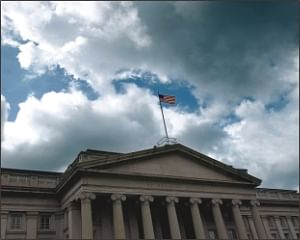Great Depression memories come into play

Clouds are seen above the US Treasury on Friday in Washington, DC. US Treasury Secretary Henry Paulson has announced that the Treasury will insure money market mutual funds as one part of a massive government bailout that is attempting to stabilise the current financial crisis.Photo: AFP
While its details have not been formally disclosed, economists say a US government plan to rescue the financial industry described as the "mother of all bailouts" will not be a simple task and could cost up to a trillion dollars.
Treasury Secretary Henry Paulson said the rescue plan, drafted with the Federal Reserve and Congressional leaders to help purge bad assets from the banking sector, will cost the government "hundreds of billions" of dollars.
"This needs to be big enough to make a real difference and get at the heart of the problem," Paulson told reporters.
The proposal was sent to Congress late Friday, an administration official said. According to The New York Times, it is likely to cost 500 billion dollars, with some experts predicting the cost could run as high as one trillion.
Analyst Mary Ann Hurley at DA Davidson & Co. called the plan the "mother of all bailouts" and said it seemed to "establish a toxic debt dumpster to purge the banks of bad debt."
"The trillion dollar question (is) how will the government price the toxic debt?" she added. "Will the banks and financial institutions still have to suffer severe losses?"
Some said the massive rescue could be modeled on the Resolution Trust Corp. established to clean up US savings and loans after huge losses for those depository institutions in the 1980s, but the form of the new entity was not immediately clear.
Nouriel Roubini, a New York University economist, said the government should revive the Depression-era Home Owners' Loan Corporation (HOLC) to "buy impaired mortgage assets at a discount from banks rather than a RTC that restructures assets from already-defaulted banks."
He added that "buying up mortgages assets at a discount may push some banks into insolvency as they would have to book the lower value and take the writedown against capital that might not be there," and that another effort may be needed to recapitalise banks.
Senator Charles Schumer proposed a strategy rooted in the Depression, arguing that the RTC model would involve taking distressed assets off the books of troubled banks and transferring "excessive risk to the US government without addressing the plight of homeowners."
Schumer proposed using a model from the 1930s called the Reconstruction Finance Corporation to stabilize the banking system. This would provide capital to struggling financial institutions in exchange for an equity or preferred stock stake in the banks.
Brian Bethune, economist at Global Insight, said that "what is lurking in the balance sheets of commercial and investment banks and insurance companies, no matter how we try to reshuffle the deck, is about 1.25 trillion dollars of illiquid mortgage assets."
He said banks have already written off around 500 billion dollars leaving nearly 800 billion dollars to deal with, although not all of these assets are held by US banks.
Because of a lack of trading in these assets, Bethune said "it is difficult, if not impossible to assign a fair market value" but that it could be fair to assume a writedown of 60 percent or more.
"The initial cost will be in the hundreds of billions of dollars, to be funded by the US Treasury," he said.
"However, the ultimate cost to the taxpayer should be much lower, presuming that the economy and the housing market recover perhaps in the second half of 2009 and 2010."
Other Depression-era tools were being used to steady a financial system reeling from a housing meltdown that has engulfed the financial sector.
The Treasury on Friday agreed to insure money market funds under the Exchange Stabilisation Fund, established by the Gold Reserve Act of 1934 to promote financial stability.
"If you are a fan of irony, consider this: The conservative movement has utterly hated FDR (Franklin Roosevelt), and his New Deal programs," said Barry Ritholtz of Ritholtz Research and Analytics.
"We now see that the grand experiment of deregulation has ended, and ended badly. The deregulation movement is now an historical footnote, just another interest group, and once in power they turned into socialists."
Conservative columnist Michelle Malkin noted that "this is a Republican White House presiding over the mother of all bailouts."
Since the rescues began, she said "we've heard that every bailout step was just a one-off. Each step was supposed to calm the markets ... Each new package of goodies rewarding irresponsible behavior and bad financial decisions was supposed to prevent new ones. None did. And now, here we are.”

 For all latest news, follow The Daily Star's Google News channel.
For all latest news, follow The Daily Star's Google News channel. 



Comments